11 Tips And Tricks For Making Ultra-Rich Biscuits And Gravy
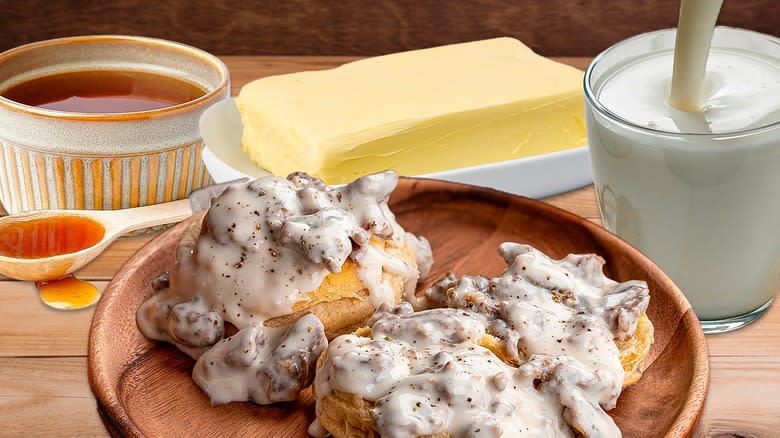
Anyone who watches the Great British Baking Show knows there is a certain amount of transatlantic confusion over what constitutes a biscuit. I'm French-British, and where I grew up, a biscuit refers to a cookie, preferably a very crunchy one, although we then dip it in tea to make it soft again. I was understandably confused when the mother of an American friend told us we would have biscuits and gravy for breakfast. I pictured cookies covered in a meaty broth, which seemed an incongruous mix — until I took a bite and discovered this wonderful dish: Fluffy, thick biscuits smothered in a rich, salty sausage gravy.
Born in Southern Appalachia in the 1800s, biscuits and gravy have since become a staple of Southern cuisine. It is no wonder: They are nourishing, quick to make, and involve readily available ingredients, such as butter, milk, and flour. More importantly, they are delicious.
I found myself craving them, so I decided to learn to cook the dish, which is woefully unavailable in Europe. I scoured the internet for tips and reached out to Zoe Biron, chef and owner of Butler's Pantry, a breakfast-and-brunch eatery in Stowe, Vermont. Several food critics have lauded her biscuits and gravy — according to Lonely Planet: "The biscuits and gravy here are legendary." With Biron's help, we have established 11 tips and tricks that will take your biscuits and gravy to the next level.
Read more: 15 Different Ways To Cook Fish
Use Cold, Unsalted Butter
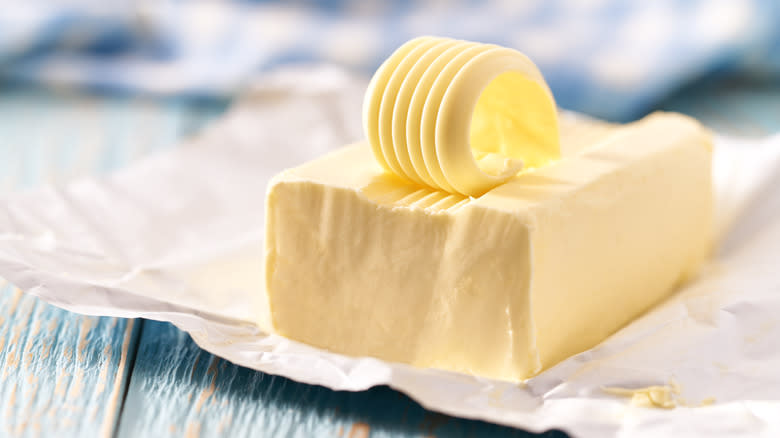
When it comes to making biscuits, butter plays an important role not just in shaping flavor but also in texture. "We lightly mix in cold, grated butter, which keeps the biscuits light," explains Zoe Biron.
When you incorporate cold butter into the dough, it creates pockets of fat that progressively melt during baking. This generates steam, helping the dough to rise and creating flaky, tender layers. This means a light, well-textured biscuit rather than one with a closed and heavy consistency. If you use room temperature or warm butter instead of cold, it will be absorbed into the rest of the dough without having the time to make these light layers.
That's why many chefs recommend using butter straight from the freezer. The late Anthony Bourdain went one step further, recommending a rather tedious, multi-step process for incorporating butter. His 2016 cookbook "Appetites: A Cookbook" instructed the baker to freeze the butter, then place it for five minutes at room temperature. It should then be cut into cubes, and placed into the refrigerator until time comes to add it to the dough. If this seems too long-winded, simpy grate frozen butter into your dough.
While we are on the subject of the ideal fat, it is highly recommended to use unsalted butter to avoid baking salty biscuits. As sausage gravy is quite sodium-heavy, you may want a slight contrast or neutrality from your biscuits. Using unsalted lets you control this level.
Use Buttermilk For The Best-Textured Biscuits

The second secret to a perfectly textured biscuit lies in another ingredient from the dairy aisle. For what Zoe Biron describes as a "pillowy," "tender," and moist inside, she uses buttermilk rather than plain milk in all her biscuits.
Buttermilk is a tangy, fermented dairy product made by adding bacterial cultures to low-fat or non-fat milk, resulting in a thicker, slightly sour liquid. The acidity of buttermilk reacts with the baking soda in the dough, releasing bubbles of carbon dioxide. This helps the biscuits to rise, giving them a fluffier texture. The acidity also helps break down the strands of gluten in the flour, making the texture less breadlike and more tender and crumbly.
Buttermilk gives a slightly sour tang to your biscuits, which works very well with the rich butteriness of the biscuits and balances the savory elements of the sausage gravy. On top of improving the flavor and the texture of your biscuits, buttermilk also helps keep them moist. It has a higher fat content than regular milk, which helps retain moisture in a true Southern homemade biscuit recipe.
Don't Overhandle Your Dough
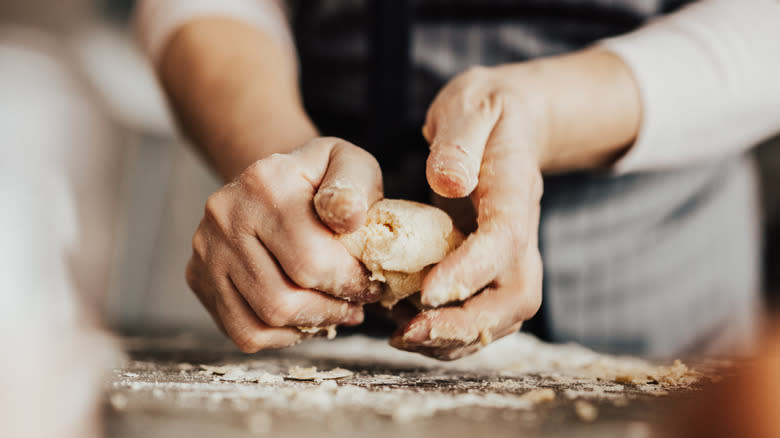
One of the most common mistakes people make when baking is to overhandle their dough. Whether you are making bread, pastry, or biscuits, overzealous handling can destroy the texture of your finished product.
As Zoe Biron explains, "Minimizing mixing and handling the dough too much keeps the biscuits from becoming dense". This is due to the fact that overworking the dough overactivates the gluten in the flour, resulting in tough, dense biscuits rather than the tender, flaky ones you're aiming for.
The key to achieving light, fluffy biscuits is to mix the dough as little as possible. When combining your ingredients, mix just until they come together. It's okay if the dough looks a bit shaggy or if there are some dry spots; these will hydrate as the dough rests. Once the dough is mixed, handle it gently when rolling it out. Use a light touch when cutting out your biscuits, and avoid twisting the cutter.
By minimizing the handling of your dough, you make sure that the butter remains in small, cold pieces, which will create fluffy layers while baking. If you want to accentuate those layers, you can fold the dough a few times before cutting out the biscuits. This technique creates layers, similar to making puff pastry, which helps to form the flaky texture characteristic of good biscuits. However, even with folding, be careful not to overdo it. Three to four folds are usually enough.
Use Good Quality Sausage — Or Better Yet, Make It Yourself

When it comes to making gravy, sausage is the star ingredient and the most important decision to make. Don't skimp on quality, as a good sausage makes a significant difference to the richness and flavor of your dish. Cheap, processed sausages often contain fillers and preservatives, and they will create a more bland and chewy gravy. Instead, choose a rich sausage with a high meat content and minimal additives. If you can, source your sausage from a farmer's market or an independent butcher — they are the experts in good meat, after all.
If you want an even more incredible gravy, consider making your own sausage. This adds a meatier taste and gives you more control over the seasoning. Making sausage from scratch might seem daunting, but it's relatively straightforward. You can grind the meat yourself or ask your butcher to do it for you. Once you have your ground meat, mix in the spices and let the flavors meld for a few hours or overnight in the refrigerator before cooking.
In his iconic recipe for sausage sawmill gravy and biscuits, chef George Weld recommends mixing ground pork meat with salt, pepper, fennel seeds, and chili. He then smashes it into a patty and lets the meat caramelize before continuing his gravy-making.
Consider Adding Maple Syrup And Bacon

Biscuits and gravy are one of the very best Southern breakfasts, and some would argue that the classic flavors should not be tampered with. But life is too short not to play around in the kitchen, and some fusions are destined to be tried. Incorporating the iconic breakfast flavor of maple syrup into biscuits and gravy is one such winning combo — adding a sweet hint to the dish.
At Butler's Pantry, Zoe Biron made the somewhat risky decision to step away from the conventional recipe for her gravy. "We make the gravy using our homemade maple sausage," she explains. "It does have a hint of sweetness to it from the maple syrup; this definitely can throw some people off because it is not the classic flavor profile they would expect." Like every risky choice in the kitchen, some people love it, while others aren't too keen.
If you want to know where you stand and can't make it to Stowe, Vermont, try this maple biscuits and bacon gravy recipe. Pair maple-infused biscuits with bacon and sausage gravy for a dish that is salty, smokey, sweet, and sublime.
Try Out A Vegetarian Alternative With A Rich Mushroom And Herb Gravy

For those looking to enjoy biscuits and gravy without meat, don't worry. There are plenty of ways to make a super rich, vegetarian version that contains all the comfort and homeliness of the original dish. Alongside her maple sausage gravy, Zoe Biron also offers a mushroom and herb gravy. It is very popular — even amongst meat-eaters.
"A lot of people order a mix of sausage and mushroom gravy, which cuts a bit of the sweetness out and lightens the dish up a bit with that herby flavor," she says. Mushrooms, with their umami richness, are an excellent base for a vegetarian gravy, and herbs add an enjoyable freshness and lightness to the dish.
When making mushroom gravy, try mixing different types of mushrooms. Three that are known for being good meat replacements are cremini, shiitake, and portobello . Cremini mushrooms have a mild, earthy flavor and a meaty texture. Shiitake mushrooms add a slightly smoky and umami taste, while portobellos have a robust cap and a rich mushroom flavor. By combining these mushrooms, you'll obtain a great meaty texture and richness that rivals traditional sausage gravy.
If you follow a plant-based lifestyle, you can easily make your mushroom gravy using non-dairy milk as a substitute for cow milk. Cashew milk, oat milk, or soy milk are excellent choices, as they have a neutral flavor and a creamy consistency that works well in gravies.
Keep The Gravy Light By Using Milk, Rather Than Cream
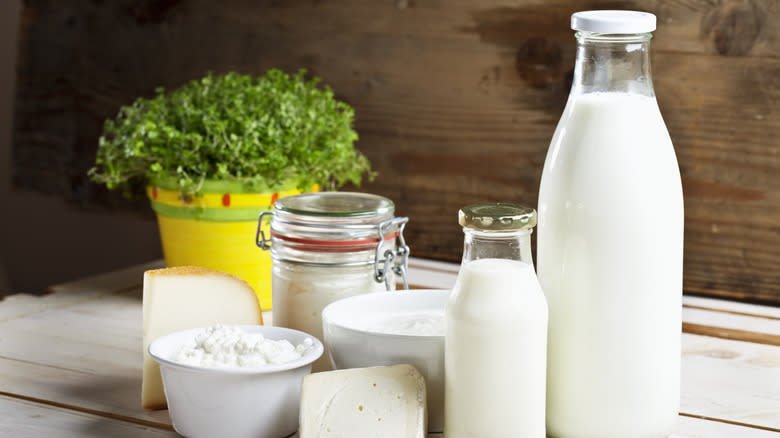
For classic biscuits and gravy, you need a thick, rich, creamy gravy. Interestingly, though, you don't actually need cream, which can make the dish too heavy or thick. That's why Zoe Biron recommends using milk instead. The gravy "remains a bit lighter than if you were to add cream, but you still get a rich texture from the roux," she says.
Although it's rare, some recipes do call for using heavy cream in a sausage gravy. It isn't necessary as long as you can make a good roux. Roux, a mixture of fat and flour cooked together, creates a smooth, thick base for the gravy.
For a great sausage gravy recipe, make a roux with equal parts butter and flour. Cook the roux over medium heat until it turns a light golden color. This removes any lingering taste of raw flour. Gradually whisk in milk, continuing to stir until the mixture thickens and becomes smooth. Season with salt, pepper, and any additional spices or herbs you would like.
Perfect The Seasoning Of Your Gravy
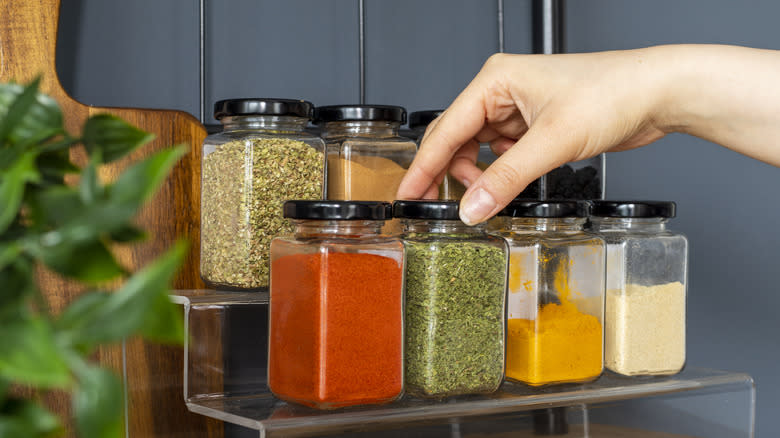
When it comes to seasoning sausage gravy, everyone has their own idea of which herbs and spices to use. It is a good idea to play around with different variations to find which one you prefer. This also happens to be a great excuse to cook (and eat) plenty of biscuits and gravy, all in the name of achieving culinary satisfaction.
Generally, sausage gravy is made with herbs, which cut through the meatiness. Fresh herbs like parsley, chives, and rosemary can brighten up the flavor of your gravy. Add them towards the end of cooking to maintain the most vibrancy. Black pepper is another staple in sausage gravy, and if you are a fan of spice, try adding paprika or chili flakes. These add a pleasant heat, complimenting the sweet and savory flavors of the dish. Salt shouldn't be forgotten. It is best to add it in gradually, to make sure you get the perfect level.
Other delicious but less common ingredient for sausage gravy include a squeeze of lemon juice to cut through the richness of the gravy and add a citrusy note that balances the flavors. A dash of Worcestershire sauce adds a savory, umami depth, giving the dish subtle undertones and a complexity of flavors that some chefs, like Alex Guarnaschelli swear by.
For A Spicy Twist: Swap Your Sausage For Chorizo
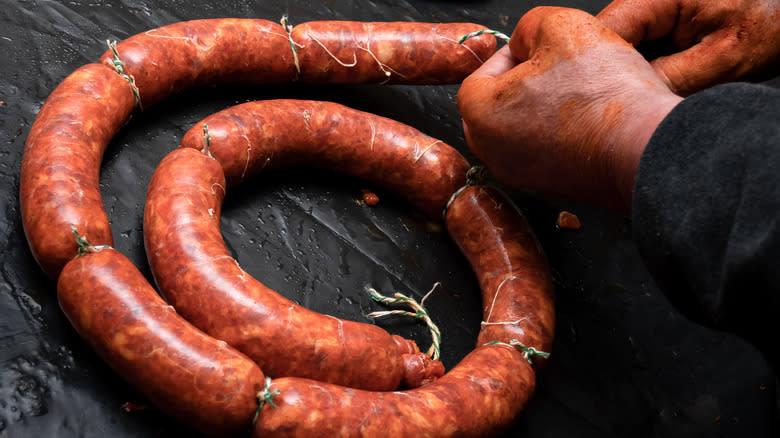
While herbs and spices allow you to tweak your flavors and take your sausage gravy in many different directions, there is one ingredient swap that can transform the dish entirely: Instead of breakfast sausage, use chorizo for a spicy twist on biscuits and gravy.
There are two main types of chorizo: Mexican and Iberian. Mexican chorizo is made from raw ground pork and seasoned with chili powder, garlic, and other spices. In contrast, chorizo from the Iberian peninsula, meaning Spain and Portugal, is dried and cured like salami, flavored with smoked paprika and garlic. It is often eaten in slices as an appetizer.
You should use the Mexican variety for chorizo gravy. Cook it until fully browned, then continue your gravy-making process. Chorizo releases a lot of spicy, flavorful fat, so you won't always need to add butter to make your roux. Drain excess fat, leaving around 2 or 3 tablespoons in the pan, then add flour, letting it cook in the grease.
Using chorizo in place of regular sausage not only adds a spicy kick but also provides a lovely smoky flavor. Plus, the spices in the chorizo turn the gravy a vibrant red-orange color. This is a great one to serve guests; impressive but not fussy. If you find chorizo a bit too spicy, you can adjust the amount to your taste. For those who crave even more chili, pair your chorizo gravy with roast jalapeño biscuits.
For Large Groups, Make Biscuits And Gravy As A Sheet Bake
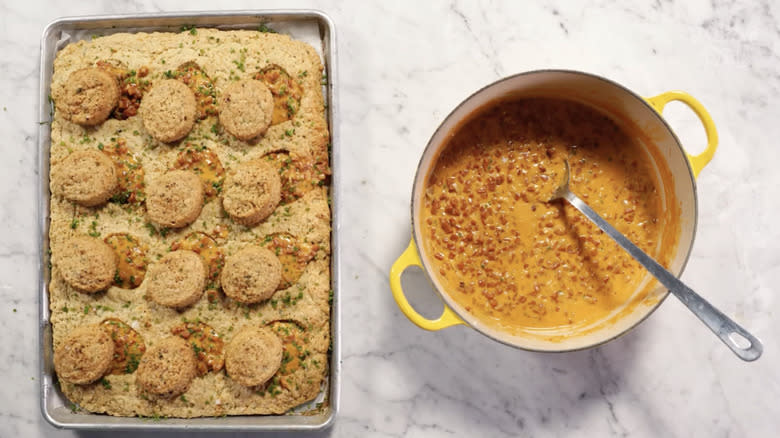
Biscuits and gravy are a sure-fire crowd-pleaser, but they aren't always the easiest dish to make in large quantities. They require the cutting out of countless biscuits and the painstaking dishing up of equal amounts of gravy. Plus, making dough in large quantities can lead you to overwork it, losing the light texture you want from your biscuits.
One way around this is to prepare a sheet-pan biscuits and gravy recipe. Roll out your biscuit dough to the size of a baking sheet. Cut out circles, and bake both the cutouts and the remaining sheet of dough. Pour your gravy over the sheet, place the biscuits on top, and sprinkle with fresh herbs. Single it is essentially a soaked biscuit, your pastry may be a bit softer. But to prevent your biscuits from becoming soggy, wait until your guests arrive to make, and then only pour additional over top before serving. This whole process can be completed in under 30 minutes, making this a quick and easy group meal.
Eat 'Em Fresh, Or Keep 'Em Fresh

By now, you have mastered the art of making biscuits and gravy so delicious that there will be no leftovers. Still, you might face a situation where you want to keep some for later or have a frozen batch in your freezer for emergencies. So, how long can you keep biscuits and gravy, and what is the best way to freeze them?
Freshly made biscuits can be stored at room temperature for up to two days. To keep them soft, place them in an airtight container or wrapped in aluminum foil. If you want to keep them longer, biscuits can be stored in the freezer for up to three months. Allow them to cool completely before freezing to prevent moisture buildup, which can lead to freezer burn. When possible, freezing the dough is a better option than freezing baked biscuits, as it helps preserve the texture and gives you that freshly baked taste when you finally eat them!
Gravy can be stored in the refrigerator for three to four days. If you want to freeze it, allow it to cool completely then transfer to airtight containers. When it's time to thaw frozen gravy, move the container to the refrigerator and let it defrost overnight. This gradual thawing process helps maintain the gravy's texture and safety. Once thawed, reheat the gravy on a low heat, stirring occasionally until it reaches the right thickness.
Read the original article on Tasting Table

